- Home
- Victor Hugo
Les Miserables (abridged) (Barnes & Noble Classics Series) Page 3
Les Miserables (abridged) (Barnes & Noble Classics Series) Read online
Page 3
1866 Guernsey provides the setting for Hugo’s regional novel Les Travailleurs de la mer (The Toilers of the Sea). Edgar Degas commences his series of ballet paintings. Works of Cézanne, Renoir, Monet, and other Impressionists appear. The next year Emile Zola’s novel Thérèse Raquin is published.
1868 Hugo’s wife, Adèle, dies unexpectedly in Brussels. She had been living apart from Victor for several years, but the two had remained friends.
1869 Hugo publishes the historical novel L‘Homme qui rit (sometimes translated By Order of the King). He declines a second offer of amnesty from Napoleon III. Sainte-Beuve dies.
1870 Defeated by the Prussians at Sedan, Napoleon III surrenders to them and is deposed. France’s Third Republic is proclaimed. Hugo returns to Paris in triumph after nineteen years in exile.
1871 Hugo is elected to the National Assembly, but resigns due to the opposition of right-wing members. His son Charles dies.
1872 Consumed by madness, Hugo’s daughter Adèle is institutionalized until her death in 1915. Jules Verne’s Around the World in Eighty Days is published.
1873 Hugo’s younger son, Francois-Victor, dies. Arthur Rimbaud’s A Season in Hell is published.
1874 Hugo publishes Quatrevingt-treize (Ninety-three), a historical novel about the counter-revolutionary rebellion in la Vendee, and events leading to the Reign of Terror in 1793. He provides nuanced portraits of both sides.
1876 Hugo is elected to the Senate.
1877 As senator, Hugo plays a leading role in preventing Marshal Marie Edmé MacMahon from becoming dictator of France. Because the monarchists have split their support among various claimants to the throne, the republicans achieve a working majority. The second volume of Hugo’s poetic history of the world, La Légende des siècles, appears.
1878 A stroke leaves Hugo incapable of composing additional literary works.
1880 After years of efforts, Hugo arranges amnesty for the Com munards, popular-front rebels in the Paris of 1871 opposed to surrender to the Prussians. Some 20,000 of them, including women and children, had been slaughtered by French government troops—more than the total of those guillotined during the Reign of Terror in 1793. Guy de Maupassant’s collected Contes (Stories) are published.
1881 On February 26, Hugo’s birthday, a national holiday is proclaimed, and 600,000 marchers pass his windows. The street where he lives is renamed L‘avenue Victor-Hugo.
1882 Hugo is reelected to the Senate. His play Torquemada (1869) is performed.
1883 Juliette Drouet, Hugo’s mistress since 1833, dies after a prolonged struggle with cancer. The final volume of Hugo’s poetic history of the world, La Légende des siècles, appears.
1885 Victor Hugo dies May 22. Two million mourners pass his coffin underneath the Arc de Triomphe. Hugo is entombed in the Panthéon, the first of a series of culture heroes and great leaders to be placed there. June 1 is declared a day of national mourning. Posthumous publications will enhance his reputation for decades—notably, the verse collections La Fin de Satan (The End of Satan, 1886), Toute la lyre (1888,1893), and Dieu (1891). His experimental plays, eventually published in a Pléïade edition as “Le Theatre en lib erté,” brilliantly anticipate the Theater of the Absurd in the 1950s.
1902 On the centenary of his birth, the French government opens the Maison de Victor Hugo museum in the apartment where he once lived on la place des Vosges.
1912- In collaboration with André Antoine, the director of the 1918 naturalistic Théatre-Libre, the filmmaker Albert Capellani, with the Pathé firm, produces a series of movies based on Hugo’s works: Les Misérables (1912), Marie Tudor (1912), Quatrevingt-treize (1914), and Les Travailleurs de la mer (1918).
1926 The Buddhist sect, Cao Dai, originates in Vietnam. It now has about 2,000 temples and several million followers worldwide. The worshipers venerate Hugo and his two sons, whom they believe, return to earth, reincarnated.
1975 François Truffaut’s film Adèle H., retelling the tragedy of Hugo’s second daughter, wins Le Grand Prix du Cinema Français.
1980 Alain Boublil and Claude-Michel Schoenberg create a rock-opera version of Les Misérables. Translated into English, the musical has been produced internationally more times than any other—Cats being the previous record holder.
1996 Walt Disney issues an animated, freely altered film version of The Hunchback of Notre Dame, distinctive in its politically correct treatment of gypsies, women, and persons with disabilities.
INTRODUCTION
Background
Victor Hugo (1802—1885) was a child prodigy with a precocious vocation as a creative writer. He would excel in the novel, the essay, drama, and poetry. He became an instant celebrity when he received honorable mention in a poetry contest sponsored by the Académie Française in 1817. Concerning the construction of varied versification and stanzaic form, he would soon demonstrate a virtuosity that only Goethe and Shelley could rival in Europe. In 1819 and 1820 he received two annual prizes for odes submitted to the prestigious national contest, the Jeux Floraux in Toulouse. In the latter year he and his two older brothers founded a literary magazine, for which he wrote 112 articles and twenty-two poems in sixteen months. In 1821 he met the priest Félicité de Lamennais, who greatly influenced Hugo’s views on the importance of the social utility of Christianity, a perspective that was to dominate Les Misérables forty years later. He became the leader of the French Romantic movement in 1827. Inspired by Shakespeare, he formulated a romantic esthetic based on the shocking, incongruous juxtaposition of the sublime and the grotesque, which exemplified most of his novels, including Les Misérables, in which the Thénardier couple embody the grotesque.
The visionary bent that is so pronounced in Les Misérables emerges in Les Feuilles d‘automne, one of Hugo’s greatest collections of verse, in 1831. In the early 1830s, Hugo began to elaborate a visionary system of theodicy influenced by the Jewish Kabala that claimed God had had to conceal his grandeur from humans (the sun and stars are his masks), so that they could act independently and earn salvation without being overwhelmed by the unmediated spectacle of God’s glory. Only thus was free will possible. Regarding Creation itself, Hugo held the organic worldview widespread in European romanticism: as the DNA in a single cell allows modern geneticists to identify the creature from which it came, so the spark of spirituality inherent in every part of Creation allowed the visionary romantic writers to intuit its divine source. Thus the physical world can guide humans—more accurately, it allows poet-priests to guide their fellows—toward God. Hugo believed that all creation was ordered by hierarchy as well as affinity; it consisted in an endless gradated array of all conceivable creatures, separated by infinitesimal degrees of spiritual excellence. Humans, he thought, would be rewarded or punished by being reincarnated in “higher” (angels) or “lower” (animals, plants, and objects) forms after death, depending on how meritorious their lives had been. Once reincarnated in lower forms, they could see God directly, but could only suffer passively from memories of their sins and from their remoteness from the Creator, as they gradually expiated those sins. As for the angels, none fell after the fall of Satan and his legions, and the remaining angels plus new angels evolving from the ranks of saintly humans would gradually evolve toward a closer affinity with the Godhead—always separated from it, however, by an infinite spiritual distance. At the end of time, all living things, even Satan, would be saved, and reabsorbed into the bosom of God, from which they had emerged at the Creation. This theological system is close to the Pelagian heresy of early Christianity. As Hugo put it in the final lines of his collection of visionary poetry, Les Contemplations, at the end of time Jesus will lead his brother Satan by the hand up the stairs of heaven, and God will no longer be able to tell them apart. Les Misérables explicitly states this view: “The book which the reader has now before his eyes is, from one end to the other, in its whole and in its details, whatever may be the intermissions, the exceptions, or the defaults, the march from evil to good,
... from nothingness to God. Starting point: matter; goal: the soul. Hydra at the beginning, angel at the end (p. 698).” Not only did Hugo sketch and expound this vision throughout the last half-century of his career, but also he reserved many visionary poems that he planned to have published at five-year intervals after his death—and thanks to his faithful executors, they were. The posterity of his religious ideas, although unexpected, would have gratified him. The cult of Cao Dai Buddhism, which numbers several million adherents and several thousand temples throughout the world, believes that several of its priests are reincarnations of Hugo and his sons.
Hugo’s election to the Académie Française in 1841 consecrated the militant romantic movement. In 1845 he was appointed as a pair de France, equivalent to a member of the British House of Lords. Becoming increasingly liberal in politics, he became a member of the Constitutional Convention (Assemblée Constituante) of the Second French Republic in 1848. He presided over the International Peace Conference in Paris in 1849, and there gave the first known speech advocating the creation of a “United States of Europe,” a vision partially anticipated by Immanuel Kant, Thomas Jefferson, and Madame de Staël, but fully realized only recently with the formation of the European Union, followed by the adoption of a common currency, the Euro.
Starting in 1848, Hugo and his son Charles founded and coedited the liberal newspaper L’ Événement, which strongly supported the return from exile, and the candidacy for President of the Republic, of Louis Napoleon, Emperor Napoléon I’s nephew, who had established his credentials as a liberal with a term in prison. Hugo proved to have been “a useful idiot,” for Louis Napoleon craved absolute power, and eventually managed a combination of elections and a coup d‘état to become Emperor for Life on December 2,1851. Hugo had already broken with the Right and formally declared himself a Republican on July 18,1851. Hunted by the police, with his sons already jailed, he fled France to take refuge on the English Channel Islands of Jersey (1852—1855) and Guernsey (1855—1870). Unlike all his prominent contemporaries, he refused amnesty, and published vehement satires of the new regime, Napoléon le petit (1852) and Les Châtiments (1853). When he had vented his rage against the ruler who betrayed him, he turned inward to meditate on Providence and human spiritual destiny in the great poem cycles Les Contemplations (1856, mainly composed 1853—1855), La Légende des Siècles (1859, with sequels published in 1877 and 1883), La Fin de Satan (composed 1854, published 1886), and Dieu (composed 1855, published 1891). Only then, after nearly a decade in exile, did he synthesize the individual, the historical, and the cosmic in Les Misérables.
Motivated is not determined: many people have experienced family situations similar to Hugo‘s, but there is only one author of Les Misérables. Nevertheless, numerous factors in Hugo’s life converged to reinforce his proclivity to become a savior, particularly by advocating compromise. His parents became estranged, lived apart, and each took a lover when he was only one year old. In response, he later elaborated the myth that his mother was a monarchist and his father a republican; the compromise of a constitutional monarchy such as Louis Philippe’s (1830—1848) was therefore attractive to him, and under it he began his political career, symbolically finding a middle ground between his two parents’ supposed positions. In fact, however, his mother’s family was closely associated with the Jacobins (rabid egalitarians), who massacred rebellious monarchists in the Vendee region. She later became a monarchist of convenience, while her lover was conspiring against the Emperor Napoleon.
Hugo opposed the death penalty (the uncompromising solution par excellence for crime), not only because of the influence of his older friend Charles Nodier, but also because, as a small child, he had seen the severed heads of freedom fighters in Spain and Italy nailed to church doors by the troops commanded by his father, General Hugo, charged with suppressing independence movements in those countries. The violent insanity of his older brother, Eugène, which first became obvious at Victor’s wedding with Adèle, the woman Eugène also loved, inflicted survivor guilt on Hugo, as did the premature death of his beloved younger daughter Léopoldine, who drowned with her husband and her unborn child in a boating accident shortly after her marriage, and the insanity of his older daughter Adèle, to say nothing of the early death of his two sons before him. Under the circumstances, the possibility of finding Léopoldine again after death was a comforting thought, and Les Contemplations is framed with hopes for their reunion.
His enforced sojourn on an island left a strong imprint on that work. First of all, it reflects a powerful nostalgia for Paris, where he had lived—all the more so because Napoleon III’s assistant for urban renewal, Baron Haussmann, tore up many old neighborhoods to open wide avenues down which it was easy to fire grapeshot from cannons to disperse rebellious crowds. The constant presence of the sea makes itself felt continually in the visionary poetry, but it probably also inspired several scenes in Les Misérables, such as the galleys at Toulon, and metaphors such as the depiction of Jean Valjean, released from prison but abandoned and cursed by society, as a man overboard who slowly, agonizingly despairs and drowns. Unable to exercise his keen visual sensitivity on medieval monuments, as he had done in Paris (in several poems and essays as well as in Notre-Dame de Paris), Hugo turned to botany, gardening, and agriculture. Signs of this new interest pervade Les Misérables, but it culminates only in the rich, lovingly detailed descriptions of the flora in the introductory section of the great regional novel Les Travailleurs de la mer (1866). Surrounded by the poor, who had to make their living from the sea, Hugo found many occasions—like Monseigneur Myriel and Jean Valjean in his novel—to exercise charity. For a time, he hosted and paid for a weekly meal for fifty people. Finally, Parisian nightlife was replaced, between 1853 and 1855, by evening seances during which Hugo believed that he and his family and friends could communicate with the spirits of both the living and the dead. He summoned the soul of the sleeping Napoleon III, to harangue and intimidate him; he advised Shakespeare on how to correct errors in his prosody; and he dia logued with Jesus Christ as well as dozens of other notables.
The Story
Hugo already had composed a version of his masterpiece, first entitled Les Misères, between 1845 and 1848, during the height of his activity in the House of Peers. During fourteen months of intense activity between 1860 and 1862, Hugo expanded this original version by 60 percent. Les Misérables embeds the story of a poor workman in a vast mythic-historical context. It tells of the fall and redemption of Jean Valjean, a young tree pruner in the region of Paris, the sole support of his widowed sister and her seven children. One winter, unemployed and desperate to feed his dependents, he breaks a bakery window at night to steal a loaf of bread. He is arrested and sentenced to five years’ hard labor in the galleys of Toulon. Four escapes, attempted instinctively and unreasoningly, lead only to additional sentences, which finally total nineteen years. The harsh punishment embitters him against society, and after his release this attitude is reinforced by the scorn and rejection he experiences whenever he must show his convict’s yellow passport. But a saintly Catholic Bishop, Monseigneur Myriel, treats Jean Valjean respectfully, feeds him, and gives him lodging for the night. Despite this kindness, Valjean cannot resist stealing the bishop’s last remaining luxuries—for the cleric has given everything else to the poor—his silver place settings. When the gendarmes bring Valjean back, the bishop saves him from further imprisonment by saying he had given the place settings to Valjean. And the bishop adds the two silver candlesticks that his guest had “forgotten.” As Valjean sets off again, the bishop whispers that he has purchased the ex-convict’s soul with his gifts, that Valjean has promised him to live a virtuous life henceforth.
On the road north, a last flicker of brute instinct takes over: the convict cannot resist the temptation to steal a coin dropped by a little itinerant chimney sweep. Then he repents and resolves to lead a virtuous life, guided by an inner voice inspired by the bishop’s kindness to him. (Hugo identi
fies our conscience with God.) He manages to conceal his identity, educate himself, and transform himself into the benevolent “Monsieur Madeleine” (an allusion to the penitent prostitute Mary Magdalene in the Gospels). By inventing a superior method for making glassware, he ensures the prosperity of an entire village enriched through the “trickle-down” theory of economics. The grateful townspeople elect him mayor in a town where the rigid, self-righteous Javert, overcompensating for having been born in prison as the illegitimate son of a fortune-teller, serves as chief of police.
Meanwhile, Fantine, a young working woman in Paris, has been seduced, impregnated, and cynically abandoned by her lover. Once her baby, Cosette, is born, she innocently leaves her in the care of the evil Thénardier couple, dishonest innkeepers, and goes to her native village, where Jean Valjean has settled. She finds work there in the glassware factory, but is fired by a self-righteous female foreman who discovers that she has an illegitimate child. The Thénardiers have been starving Cosette, dressing her in rags, and forcing her to do hard labor, while sending Fantine exorbitant, fraudulent medical bills. She must turn to prostitution to support her daughter. At the same time, the Thénardier daughters Eponine and Azelma are pampered, creating a Cinderella-like situation.
“Monsieur Madeleine” finally learns of this situation when Fantine has been unjustly accused of assault against a wealthy idler who had assaulted her first. He overrules Javert, who is blinded by social prejudice, and orders her release. He promises to care for her and to reunite her with her baby. But his defense of a social outcast alienates Javert and intensifies his suspicions, which derive from his preconscious memories of having seen Jean Valjean as a galley slave at Toulon twenty years earlier, when he served as assistant warden there. His suspicions intensify when the mayor demonstrates enormous strength by lifting a heavily loaded cart to free a man being crushed beneath it. Only the former convict Jean Valjean, nicknamed “Jean le Cric” (Jack the jack), still sought for having robbed the chimney sweep, would have been capable of this feat, Javert believes. Events soon confirm the policeman’s intuition. An innocent, inarticulate vagrant, Champmathieu, has been falsely accused of stealing apples (a third offense, leading to life imprisonment). Former convicts have identified him as Jean Valjean. After intense struggles with his conscience, M. Madeleine feels morally obligated to step forward and denounce himself. He has had time to bury in the woods the fortune he made legally from glassware, but the rigid Javert will not allow him to take Cosette to visit Fantine before Fantine dies. Then Jean Valjean is sent back to the galleys.

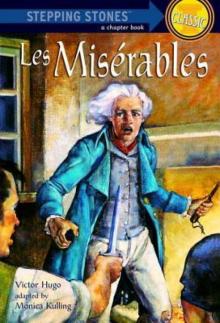 Les Miserables
Les Miserables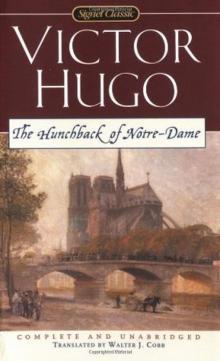 The Hunchback of Notre-Dame
The Hunchback of Notre-Dame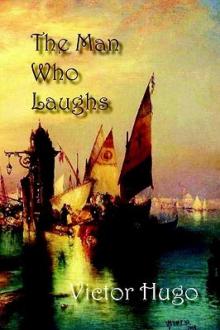 The Man Who Laughs
The Man Who Laughs The Last Day of a Condemned Man
The Last Day of a Condemned Man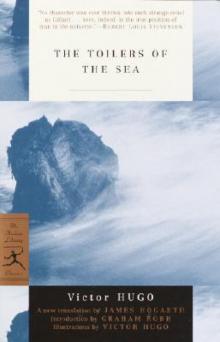 The Toilers of the Sea
The Toilers of the Sea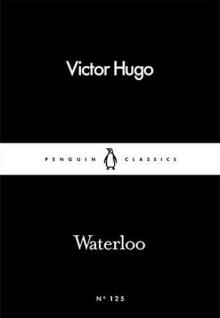 Waterloo
Waterloo Les Misérables, v. 1/5: Fantine
Les Misérables, v. 1/5: Fantine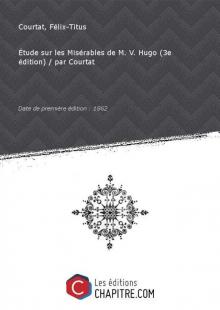 Les Misérables, v. 3/5: Marius
Les Misérables, v. 3/5: Marius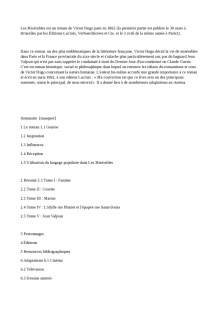 Les Misérables, v. 2/5: Cosette
Les Misérables, v. 2/5: Cosette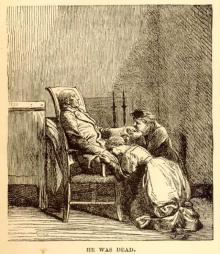 Les Misérables, v. 5/5: Jean Valjean
Les Misérables, v. 5/5: Jean Valjean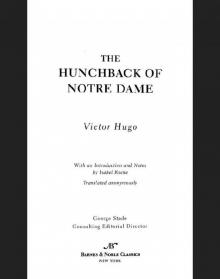 Hunchback of Notre Dame (Barnes & Noble Classics Series)
Hunchback of Notre Dame (Barnes & Noble Classics Series)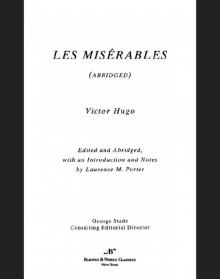 Les Miserables (abridged) (Barnes & Noble Classics Series)
Les Miserables (abridged) (Barnes & Noble Classics Series)